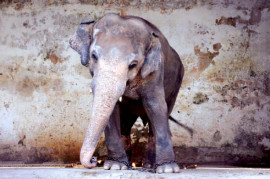
The Capital Development Authority (CDA) officials claim that chaining elephants for brief periods of time is a common practice in zoos all over the world and that the Marghazar Zoo administration is trying its best to put an end to it on its premises. It also claims that the 31-year-old Asian bull elephant Kavaan is healthy, taking his food and daily bath and that social media has portrayed a distorted picture of his condition and the affairs of the CDA-run Marghazar Zoo. The issue of Kavaan being chained on all four legs and seemingly suffering from some psychological disorder was first raised by a Pakistan-born US national, Zareen Khan, on social media after her visit to the zoo.
After Kavaan’s plight went viral, the CDA chairman hurriedly held talks with wildlife experts from the Wildlife Department of Punjab, the Animal Society, the Lahore Zoo and the World Wildlife Fund. CDA officials welcomed all expert advice for Kavaan’s welfare — agreeing on relocating him to Lahore and not sending him to a sanctuary in Myanmar. According to details gleaned from various press reports, Kavaan was brought from Sri Lanka in 1985 when it was a year-old and was a difficult animal to handle. According to its keeper of 26 years at the zoo, Bilal, the elephant had its legs chained after it attacked its keeper in late 1999.
In 1991, Kavaan was joined by a female companion, Saheli, a year-old Asian elephant calf gifted to Pakistan by Bangladesh. Saheli was always friendly towards visitors unlike Kavaan, but both elephants were kept chained despite repeated verbal and written protests by animal lovers and rights activists. The chains on Saheli’s legs eventually started cutting into its skin and a wound appeared on one of its hind legs — this was pointed out prior to its death in May 2012. Due to the zoo management’s apathy, within a matter of days a nasty infection developed forcing the elephant to limp and remain in constant pain. The two permanent veterinary doctors at the zoo failed in containing the infection, resulting in Saheli’s death at the young age of 22.
According to animal care experts, elephants, when not provided with a healthy and natural environment in captivity, suffer psychologically — similar to the way a human would in solitary confinement — and this may contribute to their ill-health and eventual death. After Saheli’s death, press reports abounded with allegations and counter-allegations between CDA officials and the elephant handlers. While two elephant handlers were suspended, no legal or disciplinary action was initiated against any CDA official, including the then director of the zoo.
After Saheli’s death, it was also rumoured that she had been poisoned by an overdose of tranquillisers. To this Zoo Director Sajjad Shah in 2012 had said, “There is politics at the zoo, therefore, urine and stool samples of the dead elephant had been sent for clinical tests to ascertain if the animal was indeed poisoned.” Furthermore, an enquiry committee was also constituted to determine the exact cause of death, while a team from the National Veterinary Laboratory collected three samples from the dead elephant for tests. None of these reports were made public and no blame appropriated. The two elephant handlers who had earlier been suspended were soon reinstated.
Furthermore, the World Wide Fund for Nature Biodiversity Director Uzma Khan in 2012 was quoted as having said, “Foot conditions are one of the reasons for mortality amongst elephants. The elephant is prone to injury when chained for long durations and this may lead to arthritis.” Khan had also cited research commissioned in the UK that stated that an elephant can only be bound while undergoing surgery. “Elephants need open spaces and an enclosure big enough but this is not the case [in Marghazar Zoo],” said Khan. She also pointed out that Pakistan does not have any legislation for zoos while India had a central zoo authority that maintained a database of zoos and simply shut down those that failed to live up to standards.
At present, there are six elephants in our zoos — two in the Karachi zoo and two at the Safari Park, one in the Lahore zoo, and Kavaan in Islamabad. Without legislation, there is little that can be done to help improve their welfare, as well as that of other animals in zoos. As Khan put it, “How do you monitor a zoo without any set standards?” After much public outcry and numerous press reports regarding a shortage of qualified and trained staff that resulted in the deaths of some rare species and continuous mistreatment of animals, the issue has finally caught the attention of the CDA authorities. The CDA wrote to the Economic Affairs Division requesting for arrangements to train staff at Marghazar Zoo. According to press reports, the contents of the letter were approved by then CDA chairman Nadeem Hasan Asif, in which help was sought in areas of animal healthcare and veterinary medicines, zoo and animal management, animal nutrition, public safety and wildlife conservation. The training is designed to improve and teach capacity-building and human resource development, among other technical expertise.
A senior official of the CDA’s Environment Wing has said that the CDA had recently formed a Zoo Advisory Committee on Animal Healthcare with representation from the private sector and animal welfare organisations, but added, “The absence of sound legislation hinders the formation of standards pertaining to animal-keeping at zoos across the country. Without legislation, one cannot question the authorities or animal caretakers running such facilities.”
Published in The Express Tribune, October 23rd, 2015.
Like Opinion & Editorial on Facebook, follow @ETOpEd on Twitter to receive all updates on all our daily pieces.

































































COMMENTS (1)
Comments are moderated and generally will be posted if they are on-topic and not abusive.
For more information, please see our Comments FAQ